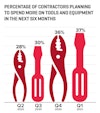Published
March 18, 2021
The Q1 2021 U.S. Chamber of Commerce Commercial Construction Index (CCI), released today, found that commercial construction contractors are growing more optimistic, mostly driven by a rise in revenue expectations. However, a deeper look reveals persistent concerns about skilled labor, trade wars, and lumber shortages.
Here are five of the most interesting findings from the new report, and what’s behind the data points.
1. The overall Index score gained a few points, but remains below where it was before the pandemic.
This quarter, the CCI rose three points to 62. However, this score is still well below pre-pandemic findings. In Q1 2020, the Index score was 74 which at the time was in the midrange of scores since the Index began in 2017.
Commercial construction seems to be mirroring the slow recovery of the overall economy, and both have a way to go before fully returning to pre-pandemic levels.
This reinforces that commercial construction is a noted cyclical industry: when the economy is going well, it tends to do well and when the economy declines, it does too. Another interesting cyclical index: the Skyscraper Index. It claimed to predict downturns in the global economy based on whether the tallest buildings in the world were being built at the time.
2. Revenue expectations drive optimism.
The main factor driving an increase in the CCI this quarter was increasing revenue expectations. Revenue—one of the overall Index’s three main indicator scores—increased five points this quarter to 57, helping to lift the overall score three points.
In fact, 36% of contractors expect their revenue to increase in the next year, up 11 percentage points from last quarter. Still, the majority (51%) expect their revenues to remain about the same in the next 12 months. But taken together these seem to indicate contractors are anticipating better times ahead.
3. Equipment spending is holding steady—at higher level.
Another interesting finding that may convey optimism about the future is contractors’ spending on equipment. If you had to suffer through Econ 101, you may know how obsessed economics professors can be with capital expenditures.

More spending on equipment is usually a good sign, indicating businesses anticipate needing more of it to meet rising demand and workloads. And according to the CCI, contractors have ramped up spending on tools and equipment since Q2 2020. This quarter, slightly more contractors (37%) plan to increase spending on tools and equipment, up one percentage point from Q4 2020, and up nine points from 28% in Q2 2020.
For comparison, in Q1 2020 before pandemic-related shutdowns, 54% said they would spend more on tools and equipment. Again, there’s still a ways to go before equipment spending reaches pre-pandemic levels, but the data here is heading in the right direction.
4. Lumber shortage concerns declined.
Lumber has seen higher demand due to a boom in residential construction since the pandemic began. The impact of this shortage spilled over into commercial construction, but there are now indications this shortage’s impact is lessening for commercial contractors.
This quarter, 22% of contractors said they are experiencing a wood/lumber shortage, down from a spike of 31% in Q4 2020. For comparison, just 5% of contractors surveyed reported a lumber shortage in Q3 2020. Still, close to three-quarters (71%) of contractors say they are experiencing at least one product shortage.
5. Trade fight worries persist.
A change in administrations in Washington has not led to a decline in concern about tariffs and trade wars for commercial contractors. Consider these survey findings:
- More (35%) contractors say steel and aluminum tariffs will have a high to very-high degree of impact on their business in the next three years, up from 24% saying the same in Q4 2020.
- 29% of contractors say new construction material and equipment tariffs will have a high to very-high degree of impact on their business over the next three years, up from 21% in Q4 2020.
- 19% of contractors expect high impacts from trade conflicts with other countries, steady from Q4 2020 (and over the past several quarters).
Based on that data, it looks like contractors are not quite convinced policymakers are ready to put trade conflicts behind them on the materials and equipment that matter most to them.
For more findings from this quarter, methodology, and shareable graphics visit commercialconstructionindex.com.
About the authors

Thaddeus Swanek
Thaddeus is a senior writer and editor with the U.S. Chamber of Commerce's strategic communications team.





